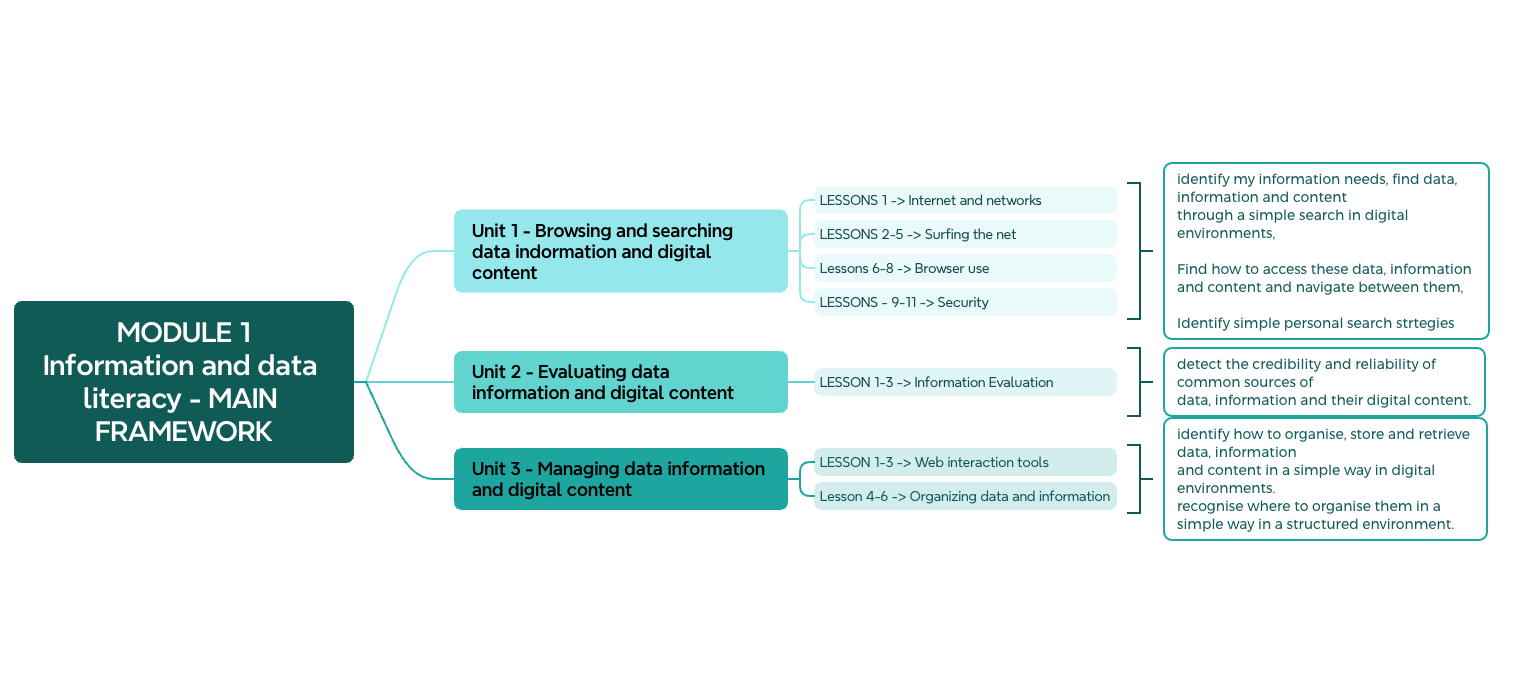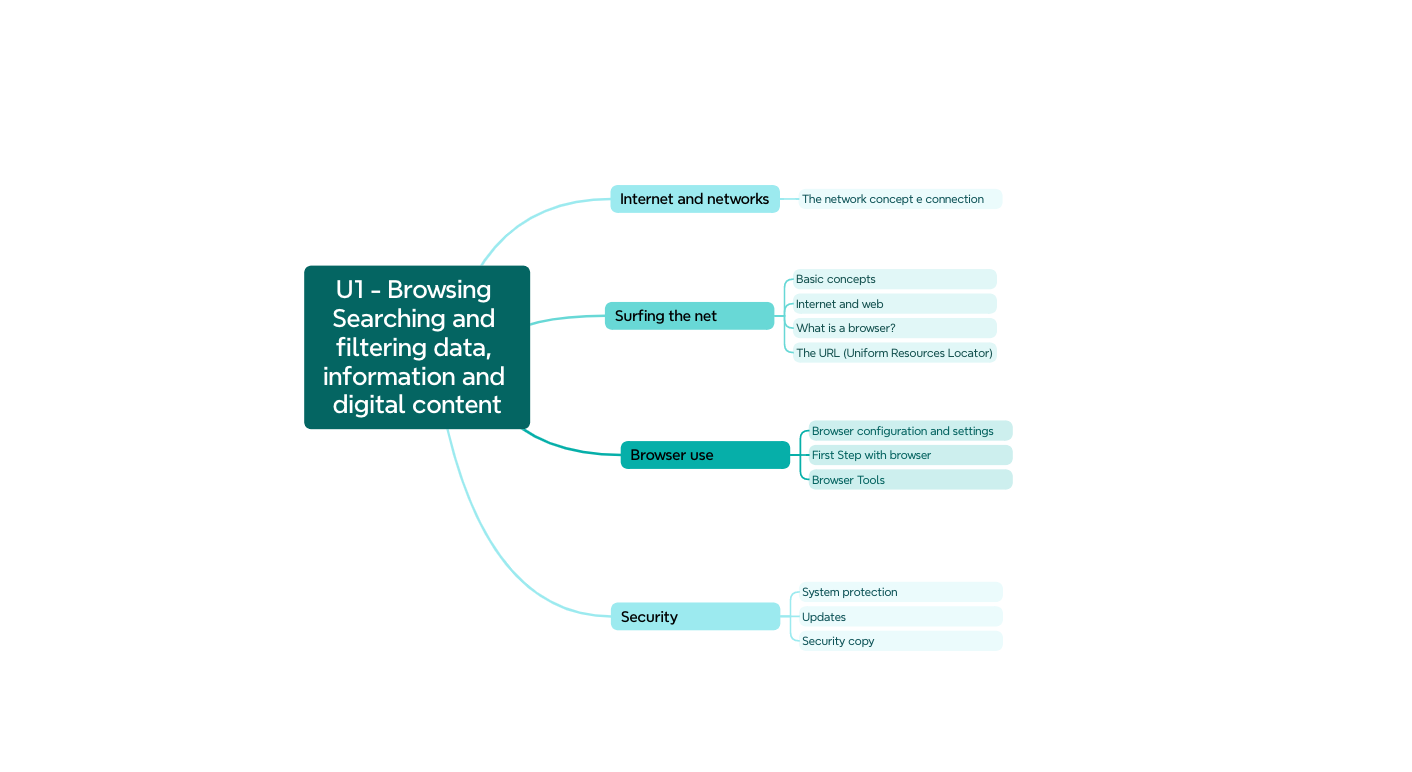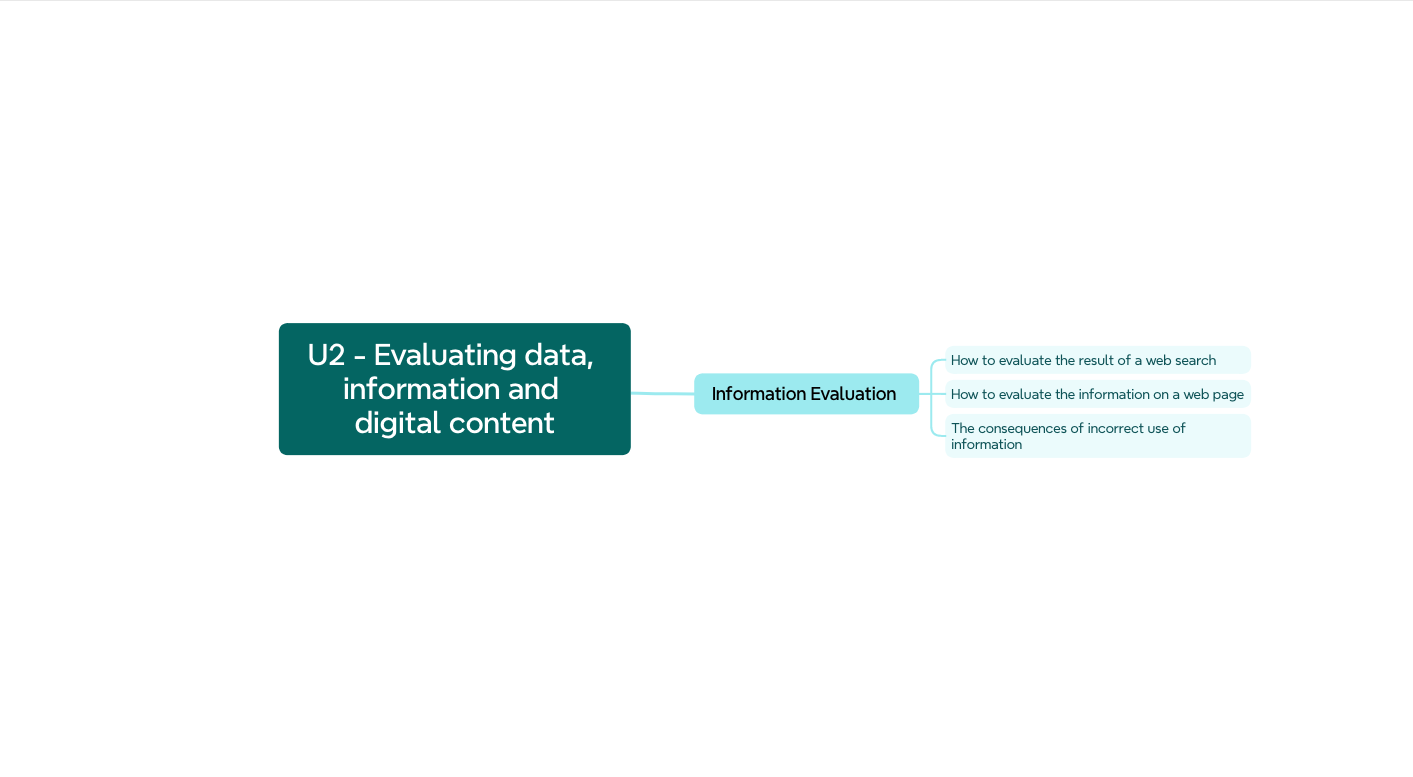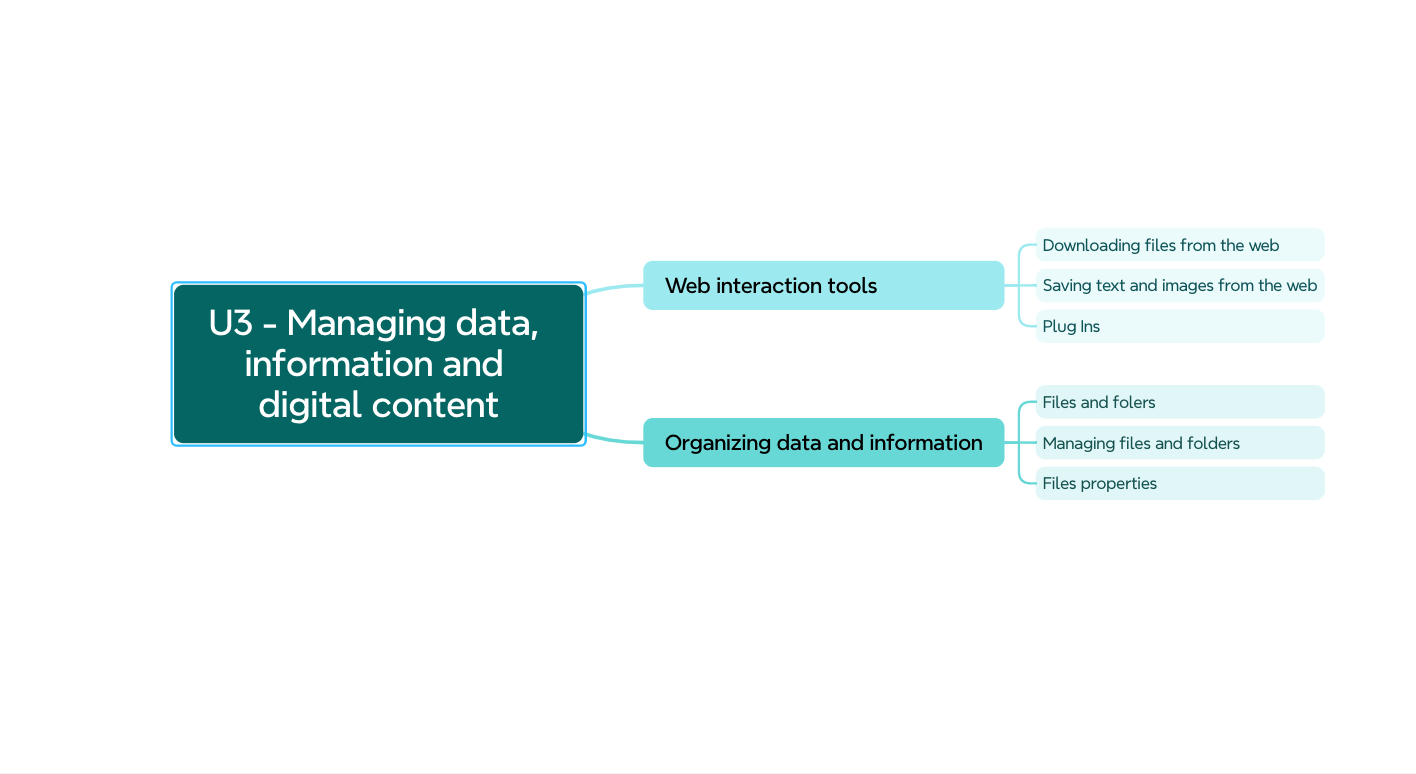This competency involves searching, locating, evaluating, managing, and organizing digital information and data.

Basic structure
Unit 1 – Browsing, searching and filtering data,information and digital content.
Knowledge
- Knows that some online content in search result may not be open access or freely available and may require a fee or signing up for a service in order to access it.
- Aware that online content that is available to users at no monetary cost is often paid for by advertising or by selling the user’s data.
- Aware that search results, social media activity streams and content recommendations
on the internet are influenced by a range of factors. These factors include the search terms used, the context (e.g. geographical location), the device (e.g. laptop or mobile phone), local regulations (which sometimes dictate what can or cannot be shown), the behaviour of other users (e.g. trending searches or recommendations) and the user’s past online behaviour across the internet. - Aware that search engines, social media and content platforms often use AI algorithms to generate responses that are adapted to the individual user (e.g. users continue
to see similar results or content). This is often referred to as “personalisation”. (AI) - Aware that AI algorithms work in ways that are usually not visible or easily understood by users. This is often referred to as “black box” decision-making as it may be impossible to trace back how and why an algorithm makes specific suggestions or predictions. (AI)
Skills
- Can choose the search engine that most likely meets one’s information needs
as different search engines can provide different results even for the same query. - Knows how to improve search results by using a search engine’s advanced features (e.g. specifying exact phrase, language, region, date last updated).
- Knows how to formulate search queries to achieve the desired output when interacting with conversational agents or smart speakers (e.g. Siri, Alexa, Cortana, Google Assistant), e.g. recognising that, for the system to be able to respond as required, the query must be unambiguous and spoken clearly so that the system can respond. (AI)
- Can make use of information presented as hyperlinks, in non-textual form (e.g. flowcharts, knowledge maps) and in dynamic representations (e.g. data).
- Develops effective search methods for personal purposes (e.g. to browse a list of most popular films) and professional purposes (e.g. to find appropriate job advertisements).
- Knows how to handle information overload and “infodemic” (i.e. increase of false or misleading information during a disease outbreak ) by adapting personal search methods and strategies.
Attitudes
- Intentionally avoids distractions and aims to avoid information overload when accessing and navigating information, data and content.
- Values tools designed to protect search privacy and other rights of users (e.g. browsers such as DuckDuckGo).
- Weighs the benefits and disadvantages of using AI-driven search engines
(e.g. while they might help users find the desired information, they may compromise privacy and personal data, or subject the user to commercial interests). (AI) - Concerned that much online information and content may not be accessible to people with a disability, for example to users who rely on screen reader technologies to read aloud the content of a web page. (DA)

Unit 2 – Evaluating data, information and digital content.
Knowledge
- Aware that online environments contain all types of information and content including misinformation and disinformation, and even if a topic is widely reported it does not necessarily mean it is accurate.
- Understands the difference between disinformation (false information with the intent to deceive people) and misinformation (false information regardless of intent to deceive or mislead people).
- Knows the importance of identifying who is behind information found on the internet (e.g. on social media) and verifying it by checking multiple sources, to help recognise and understand point of view or bias behind particular information and data sources
- Aware of potential information biases caused by various factors (e.g. data, algorithms, editorial choices, censorship, one’s own personal limitations).
- Knows that the term “deep-fakes” refers to AI-generated images, videos or audio recordings of events or persons that did not really happen (e.g. speeches by politicians, celebrity faces on pornographic imagery). They may be impossible to distinguish from the real thing. (AI)
- Aware that AI algorithms might not be configured to provide only the information that the user wants; they might also embody a commercial or political message (e.g. to encourage users
to stay on the site, to watch or buy something particular, to share specific opinions). This can also have negative consequences (e.g. reproducing stereotypes, sharing misinformation). (AI) - Aware that the data, on which AI depends, may include biases. If so, these biases can become automated and worsened by the use of AI. For example, search results about occupation may include stereotypes about male or female jobs (e.g. male bus drivers, female sales persons). (AI)
Skills
- Carefully considers the top/first search results in both text-based and audio searches, as they may reflect commercial and other interests rather than be the most appropriate results for the query.
- Knows how to differentiate sponsored content from other content online (e.g. recognising advertisements and marketing messages on social media or search engines) even if it is not marked as sponsored.
- Knows how to analyse and critically evaluate search results and social media activity streams, to identify their origins, to distinguish fact-reporting from opinion, and to determine whether outputs are truthful or have other limitations (e.g. economic, political, religious interests).
- Knows how to find the author or the source of the information, to verify whether it is credible (e.g. an expert or authority in a relevant discipline).
- Able to recognise that some AI algorithms may reinforce existing views in digital environments by creating “echo chambers” or “filter bubbles” (e.g. if a social media stream favours a particular political ideology, additional recommendations can reinforce that ideology without exposing it to opposing arguments). (AI)
Attitudes
- Inclined to ask critical questions in order to evaluate the quality of online information, and concerned about purposes behind spreading and amplifying disinformation.
- Willing to fact-check a piece of information and assess its accuracy, reliability and authority, while preferring primary sources over secondary sources of information where possible.
- Carefully considers the possible outcome before clicking a link. Some links (e.g. compelling titles) could be “clickbait” that takes the user to sponsored or unwanted content (e.g. pornography).

Unit 3 – Managing data, information and digital content.
Knowledge:
- Aware that many applications on the internet and mobile phones collect and process data (personal data, behavioural data and contextual data) that the user can access or retrieve, for example, to monitor their activities online (e.g. clicks in social media, searches on Google) and offline (e.g. daily steps, bus rides on public transport).
- Aware that for data (e.g. numbers, text, images, sounds) to be processed by a program, they have to be first properly digitised (i.e. digitally encoded).
- Knows that data collected and processed, for example by online systems, can be used
to recognise patterns (e.g. repetitions) in new data (i.e. other images, sounds, mouse clicks, online behaviours) to further optimise and personalise online services (e.g. advertisements). - Aware that sensors used in many digital technologies and applications (e.g. facial tracking cameras, virtual assistants, wearable technologies, mobile phones, smart devices) generate large amounts of data, including personal data, that can be used to train an AI system. (AI)
- Knows that open data repositories exist where anyone can get data to support some problem solving activities (e.g. citizens can use open data to generate thematic maps or other digital content).
Skills
- Knows how to collect digital data using basic tools such as online forms, and present them in an accessible way (e.g. using headers in tables).
- Can apply basic statistical procedures to data in a structured environment (e.g. spreadsheet) to produce graphs and other visualisations (e.g. histograms, bar charts, pie charts).
- Knows how to interact with dynamic data visualisation and can manipulate dynamic graphs of interest (e.g. as provided by Eurostat, government websites).
- Can differentiate between different types of storage locations (local devices, local network, cloud) that are the most appropriate to use (e.g. data on the cloud
is available anytime and from anywhere, but has implications for access time). - Can use data tools (e.g. databases, data mining, analysis software) designed to manage and organise complex information, to support decision-making and solving problems.
Attitudes
- Considers transparency when manipulating and presenting data to ensure reliability, and spots data that are expressed with underlying motives (e.g. unethical, profit, manipulation) or in misleading ways.
- Watchful of accuracy when evaluating sophisticated representations of data (e.g. tables or visualisations as they could be used to mislead one’s judgement by trying to give a false sense of objectivity.

Main content framework for Module 1 – INFORMATION AND DATA LITERACY
- Information Literacy: Involves the ability to locate, evaluate, and use information effectively. It’s about knowing how to search for information, critically evaluate sources, and use information ethically.
- Data Literacy: Encompasses the ability to read, interpret, and communicate with data. It involves understanding data sources, analyzing data, and using data to make informed decisions.
The M1 module consists of three different macro-categories, according to the DigiCom guideline document.
Each of these broad areas has been subdivided into content sub-units in order to make the utilisation modular.
The entire module is therefore composed of micro particles that make up the content as a whole.
The module was subdivided as follows:
U1 – Browsing, searching and filtering information and digital content : 11 elements
U2 – Evaluating data information and digital content: 3 elements
U3: Managing data information and digital content: 6 elements
Each unit within it is subdivided into main topics that form its backbone and act almost as a sub-structure to the modular contents that make up the same unit.
- U1 – Browsing, searching and filtering information and digital content :
Internet and networks
Surfing the net
Browser use
Security - U2 – Evaluating data information and digital content:
Information Evaluation - U3: Managing data information and digital content:
Web Interaction Tools
Organising data and information
This module of the course is designed to equip participants with essential skills in information and data literacy within the context of digital competences. Participants will develop the knowledge and capabilities needed to navigate the digital landscape effectively, critically evaluate information, and harness the power of data for informed decision-making.
The training will include a combination of theoretical sessions, hands-on exercises, and practical applications. Participants will have the opportunity to engage in group discussions, case studies, and real-world scenarios to reinforce their learning.
Upon completion of the course, participants will be better equipped to navigate the digital landscape with confidence. They will possess the skills needed to critically assess information, make informed decisions based on data.
Conclusions
The three units, and the micro-lessons contained therein, will be related to the learning content in classical form: text, illustrations etc.
Subsequently, these learning contents will be translated into multimedia and interactive tools.
This module is the incipit, it is the first step to delve into the world of digital competences. It provides an overview of how the universe of connections works, and especially how to navigate the internet—a tool that we all have at our disposal today, but that we know little about, and even less about its potential and critical aspects.
Additionally, the module covers topics related to online security and device safety, aiming for an informed management of our data. Finally, it also addresses data management and storage, as data now constitutes a part of our digital heritage. It is essential to know how to manage them effectively and securely.
The module includes a range of learning materials divided into approximately 20 lessons. At the end of these lessons, there will be a self-assessment module providing real-time feedback to the user, demonstrating the level of knowledge acquired through the presented material.
